Appaloosa
| Appaloosa | ||
|---|---|---|
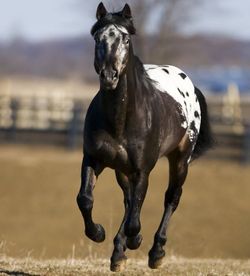 Appaloosa horse |
||
| Distinguishing features: | Most representatives have colorful spotted coat patterns, striped hooves, mottled skin and white sclera around the eye. | |
| Country of origin: | United States | |
| Breed standards | ||
| Appaloosa Horse Club: | Breed standards | |
| Horse (Equus ferus caballus) | ||
The Appaloosa is a horse breed known for its preferred leopard-spotted coat pattern and other distinctive physical characteristics. While there is evidence of leopard-spotted horses dating back to the Paleolithic era in Europe, the Nez Perce people of the American Pacific Northwest developed the American breed. They were once referred to by white settlers as the "Palouse horse," possibly after the Palouse River, which ran through the heart of Nez Perce country. Gradually, the name evolved into "Appaloosa." The Nez Perce lost most of their horses following the Nez Perce War in 1877 and the breed fell into decline for several decades. However, a small number of dedicated breeders kept the Appaloosa alive for several decades until a registry was formed in 1938. Today the Appaloosa is one of the most popular breeds in the United States, and it was named the official state horse of Idaho in 1975.
The Appaloosa is best known as a stock horse used in a number of western riding disciplines, but is also a versatile breed with representatives seen in many other types of equestrian activity, as well as in many movies. The color pattern of the Appaloosa is of great interest to those who study equine coat color genetics, as both the coat pattern and several other physical characteristics are linked to the "Lp" or "leopard" gene or gene complex, but the precise inheritance mechanism is not fully understood. The Appaloosa has influenced many other horse breeds, including several gaited horse breeds.
Contents |
History
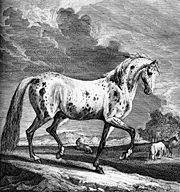
The earliest evidence of horses with a spotted coat pattern is from the cave paintings dating from the Upper Paleolithic era, circa 18,000 BC found at Lascaux and Peche-Merle in France.[1] Domesticated horses with blanket spotting patterns have also been depicted in the art of Ancient Persia, in Ancient Greece, the "Celestial horses" of the T'ang Dynasty in China, and 11th century France.[1][2][3] Paintings from France in the 16th and 17th century show horses with Appaloosa coat patterns being used as riding horses, and other records indicate they were also used as coach horses at the court of King Louis XIV of France.[4] In mid-18th century Europe, there was a high demand for horses with the Appaloosa coat pattern among the nobility and royalty. These horses were used in the schools of horsemanship and for parade and display use.[5]
The Spanish probably obtained spotted horses through trade with southern Austria and Hungary, where the color pattern was known to exist.[6] Then, the Conquistadors and Spanish settlers then brought some vividly marked horses to the Americas when they first arrived in the early 16th century.[6][7] One horse with snowflake patterning was listed with the 16 horses brought to Mexico by Cortez.[8] Additional spotted horses were noted by Spanish writers by 1604.[9] More arrived when spotted horses went out of style in late-18th century Europe, resulting in large numbers shipped to the west coast of America and traded to Spanish settlers and the Indian people of the Pacific Northwest, a voyage survived only by the hardiest animals.[10]
The Nez Perce people
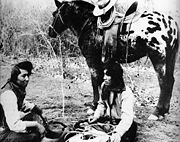
The Nez Perce people, who lived in what today is eastern Washington and Oregon, obtained horses, including many from the Shoshone people, beginning around 1700. From there took advantage of the fact that they lived in excellent horse-breeding country, relatively safe from the raids of other tribes, and developed strict breeding selection practices for their animals. By 1750, breeding herds had been established. They were one of the few tribes to actively use the practice of gelding inferior male horses, and actively traded away poorer stock to remove unsuitable animals from the gene pool,[1][11] and became known as notable horse breeders by the early 19th century.[12]
These early Nez Perce horses were considered to be of high quality. Meriwether Lewis of the Lewis and Clark Expedition wrote in his February 15, 1806 journal entry: "Their horses appear to be of an excellent race; they are lofty, eligantly [sic] formed, active and durable: in short many of them look like fine English coarsers [sic] and would make a figure in any country."[13] Lewis did note spotting patterns, saying, "...some of these horses are pided [pied] with large spots of white irregularly scattered and intermixed with the black brown bey [sic] or some other dark colour..."[13]
By "pied," Lewis may have been referring to leopard-spotted patterns seen in the modern Appaloosa,[13][14] though Lewis also noted that "much the larger portion are of a uniform colour..."[13] The Appaloosa Horse Club itself estimates that only about ten percent of the horses owned by the Nez Perce at the time were spotted.[12] While the Nez Perce originally had many solid-colored horses and only began to emphasize color in their breeding program some time after the visit of Lewis and Clark, they had many spotted horses by the late 19th century when the tribe and their horses once again came to the attention of the rest of the world.[15]
The Nez Perce War

The Nez Perce people were a relatively peaceful nation, many of whom engaged in agriculture as well as horse breeding.[16] The encroachment of gold miners in the 1860s and settlers in the 1870s put pressure on the tribe to give up much of their land,[17] and various treaties between 1855 and 1863 reduced their original treaty lands of seven million acres (28,000 km²) by 90%.[1]
Ultimately the Nez Perce drew the line at the Wallowa Valley of Oregon. While their leader, popularly known as Chief Joseph, was attempting to negotiate a new treaty, a small group of warriors attacked settlers in 1877,[17] leading to the 1877 Nez Perce War. After battles near the Salmon and Clearwater Rivers, Joseph then led about 800 of his people, mostly non-warriors, in a remarkable retreat on their Appaloosa horses, traveling southeast through Idaho and Montana and then back north across Yellowstone National Park, roughly 1,700 miles (2,700 km). They first sought refuge with other tribes including the Shoshone and the Crow Nation, then ultimately deciding to try to reach safety in Canada. A small number of Nez Perce fighters, mounted on their fast, agile and hardy Appaloosa horses, successfully held off larger forces of the U.S. Army in several skirmishes, including the two-day Battle of the Big Hole in southwestern Montana.[17][18]
However, the journey came to an end when they stopped to rest near the Bears Paw Mountains in Montana, 40 miles (64 km) from the Canadian border, thinking that they had shaken off their pursuers. But Nelson A. Miles, then a colonel, led his troops in a rapid march of over 200 miles (322 kilometers) to catch the Nez Perce. After a five-day battle, on October 5, 1877 the battle—and the war—was over.[18][19] Chief Joseph declared in his famous speech that he would "fight no more forever."[19][20]
The aftermath of the Nez Perce War
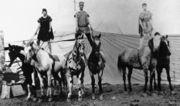
When the U.S. 7th Cavalry accepted the surrender of Chief Joseph and the remaining Nez Perce, they immediately took over 1,000 of the tribe's horses, sold what they could, and shot many of the rest. A significant population of horses had been hastily left behind in the Wallowa valley when the Nez Perce began their retreat and additional animals escaped or were abandoned along the way.[1] The Nez Perce were ultimately settled on a reservation in north central Idaho, were allowed very few horses, and were required by the Army to breed what mares they still had to draft horse stallions in an attempt to create farm horses.[21] Thus, although a remnant population of Appaloosa remained after 1877, the Appaloosa was virtually forgotten as a distinct breed for almost 60 years.[1] However, a few quality horses continued to be bred, mostly those captured or purchased by white settlers and used as working ranch horses. Others were used in circuses and in Buffalo Bill Cody's Wild West Show.[22] These horses were originally referred to by white settlers as the "Palouse horse," a reference to the Palouse River ran through the heart of what was once Nez Perce country.[23] Gradually, the name evolved into "Apalouse," and then "Appaloosa."[11][23]
Nez Perce horse breeding today
The Nez Perce tribe never regained its former position as breeders of Appaloosa horses. However, the tribe began a program in 1995 to develop a new and distinct horse breed, the Nez Perce Horse. Based on crossbreeding the Appaloosa with a Central Asian breed called Akhal-Teke, the Nez Perce hope to resurrect their horse culture, a tradition of selective breeding and horsemanship that was destroyed by the Nez Perce War. The program was financed by the United States Department of Health and Human Services, the Nez Perce tribe, and the First Nations Development Institute, a nonprofit organization that promotes tribal business development.[24]
Revitalization
In 1937, the Appaloosa had caught the eye of the general public because of a series of articles in Western Horseman magazine, and the Appaloosa Horse Club (ApHC) was founded by Claude Thompson and a small group of other dedicated breeders in 1938.[25][26] The registry was originally housed in Moro, Oregon,[26] then in 1947 moved to Moscow, Idaho.[25] The Appaloosa Museum foundation was formed in 1975 to preserve the history of the Appaloosa horse.[27]

A significant crossbreeding influence used to revitalize the Appaloosa was the Arabian horse, as evidenced by early registration lists which show Arabian-Appaloosa crossbreeds as ten of the first fifteen horses registered with the ApHC.[28] For example, one of Claude Thompson's major herd sires was Ferras, an Arabian stallion bred by W.K. Kellogg from horses imported from the Crabbet Arabian Stud of England.[29] Ferras then sired Red Eagle, a prominent Appaloosa stallion,[29] who was added to the Appaloosa Hall of Fame in 1988. Later, Thoroughbred and Quarter Horse lines were added, as well as crosses from other breeds, including Morgans and Standardbreds.[30] In 1983, the ApHC reduced the number of allowable outcrosses to three main breeds: the Arabian horse, the American Quarter Horse and the Thoroughbred.[31]
By 1978, the ApHC was the third largest horse registry in the United States.[25] Today, the Appaloosa is one of America's most popular breeds. From 1938 to 2007 over 670,000 Appaloosas had been registered by the ApHC.[32][33] The state of Idaho adopted the Appaloosa as its official state horse on March 25, 1975 when Idaho Governor Cecil Andrus signed the enabling legislation.[12] Idaho even offers a custom license plate featuring an Appaloosa horse,[34] the first state to offer a plate featuring a state horse.[35]
Breed Characteristics
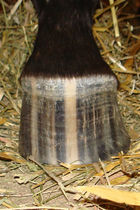
The Appaloosa is known for its preferred leopard-spotted coat pattern and other distinctive physical characteristics.[36] Because the spotting pattern is a preferred identifying factor, and because several different horse breeds influenced the Appaloosa, there are several body styles found in the breed. Due to this wide variety, Appaloosas are used in many different disciplines.
Most Appaloosas are recognized by their colorful spotted coat, striped hooves, mottled skin (most visible around their eyes and on their muzzle) and white sclera around the eye. Appaloosas can have brown, blue or hazel eyes, and an individual horse may have eyes of two different colors.[37] While the original, "old time" Appaloosas often had a sparse mane and tail, it was not a predisposition for the breed as a whole; even many original Appaloosas had full manes and tails. Today the "rat tail" trait is usually bred away from and most "modern" Appaloosas have full manes and tails.[38]
Conformation
The physical conformation of the original Appaloosa was typical of the range horses found in the western United States. Original or "old style" Appaloosas were highly regarded as hardy working horses. Many ranchers and horse breeders used roan or minimally marked Appaloosas in their programs, particularly in parts of Texas and Colorado. This had an impact on the development of the American Quarter Horse, especially with regard to the Peavy, Roberd and Casement herds.[39] Modern Appaloosas are both more refined and more muscular, reflecting the influence of Arabian and Thoroughbred breeding as well as infusions from modern American Quarter Horses and other lines.
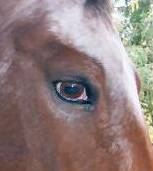
Appaloosas with a "stock horse" build are well suited to western riding disciplines as well as to short-length horse racing, at distances from 220 yards (200 m) up to a quarter-mile (400 m). The "foundation" or "working" Appaloosa is still sometimes seen, especially on working ranches. This is a slightly smaller, leaner animal considered to be closer in type to the original Nez Perce bloodstock. There are also some Appaloosas that display more of a Thoroughbred or sport horse conformation – taller, with longer legs and a leaner build, bred to be used in English riding competition and middle distance horse races up to 8 furlongs (1.0 mi).[40] A similarly spotted breed in Europe, with a sport horse build, is the Knabstrup.[1]
Color and spotting patterns
The base color of the Appaloosa horse can include bay, black, chestnut, palomino, buckskin, or any of the variations of dun and grullo. However, it is the unique spotting pattern that most people associate with the Appaloosa horse. These spotted markings are not the same as the "dapples" sometimes seen in grays and some other horse colors. Appaloosa markings overlay the base coat color, and have several pattern variations.[41]
It is not always easy to predict the color a grown horse will be from the shade it has as a foal. Most foals are born with lighter colored coats than they will have when they shed their baby hair with the exception of gray horses, which are born dark and progressively become lighter.[42]
The Appaloosa Horse Club recognizes thirteen base coat colors, which may be overlain by the following recognized spotting patterns:[41]
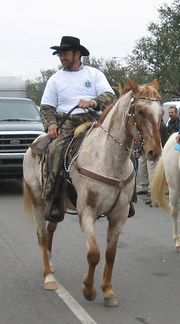
- Blanket – white over the hip that may extend from the tail to the base of the neck. The spots inside the blanket (if present) are the same color as the horse's base coat.
- Leopard – A horse whose Appaloosa white patterning is exhibited to an extreme with base colored spots of various sizes covering most of its body.
- Few Spot Leopard – This is a horse whose base color is nearly obscured by its Appaloosa white patterning covering up to 90% of its body. Horse may exhibit patches of color on the heads, knees, elbows, flanks (called "varnish marks"). Some may have as few as only one or two spots.
- Snowflake – A horse with white spots, flecks, on a dark body. Typically the white spots increase in number and size as the horse ages.
- Varnish roan – dark points (legs and head) and some spots or roaning over a light body. May occur in conjunction with another spotting style and change with age. Often starts out as a solid colored horse that gets more white as it ages, but is not a gray.
- Frost – similar to varnish but the white hairs are limited to the back, loins, and neck. May occur in conjunction with another spotting style and change with age. Often starts out as a solid colored horse that gets more white as it ages.[41]
Genetics
.jpg)
Research indicates that the autosomal dominant trait known as the leopard complex (LP) controls the presence of Appaloosa pigmentation patterns in the horse.[43] Other factors yet to be identified determine the exact spotting pattern.[44] The leopard complex has been localized to horse chromosome 1 (ECA1) and may possibly be a gene complex rather than a single gene.[43] Not every Appaloosa horse exhibits hair coat spotting. However, apparently solid-colored horses with the Lp gene will still exhibit characteristics such as vertically striped hooves, white sclera of the eye, and mottled skin around the eyes, lips, and genitalia.[45]
Sometimes, Appaloosas may also exhibit sabino or pinto type markings, but these are not desirable and are discouraged by the ApHC registration rules. The Appaloosa Project, a genetic study group, has also done extensive research on the interactions of Appaloosa and pinto genes and how they affect each other.[46] The genes that create these different patterns can all be present in the same horse. However, because pinto genes, particularly the overo pattern, may "cover-up" or obscure Appaloosa patterns, pinto breeding is discouraged by the ApHC, which will deny registration to some horses if they have excessive white markings.[47]
Registration
Located in Moscow, Idaho, the Appaloosa Horse Club (ApHC) is the principal body for the promotion and preservation of the Appaloosa breed in the United States. Affiliate Appaloosa organizations exist in many South American and European countries, as well as South Africa, Australia, New Zealand, Canada, Mexico and Israel.[48] The Appaloosa Horse Club does not release membership numbers, but the circulation of the Appaloosa Journal, which is included with most types of membership, is around 32,000 as of 2008.[49][50] The American Appaloosa Association was founded in 1983 by members opposed to the registration of plain-colored horses as Appaloosas in the color rule controversy. Based in Missouri, it has a membership of over 2000 as of 2008.[51]
The Appaloosa is "a breed defined by ApHC bloodline requirements and preferred characteristics, including coat pattern."[36] In other words, the Appaloosa is a distinct breed from limited bloodlines with distinct physical traits and a desired color, referred to as a "color preference." Thus, Appaloosas are not strictly a "color breed" as many people believe. All ApHC-registered Appaloosas must be the offspring of two registered Appaloosa parents or a registered Appaloosa and a horse from an approved breed registry, which includes Arabian horses, Quarter Horses, and Thoroughbreds. In all cases, one parent must always be a regular registered Appaloosa. The only exception to the bloodline requirements is in the case of Appaloosa colored geldings or spayed mares with unknown pedigrees; owners may apply for "hardship registration" for these non-breeding horses.[36]
In addition to the spotting patterns previously mentioned, certain other characteristics are used to determine if a horse receives "regular" registration, including striped hooves, a white ring or sclera around the eyes, and mottled (spotted) skin around the eyes, lips, and genitalia. The Appaloosa is one of the few horse breeds to exhibit skin mottling, and so this characteristic is very basic and decisive indication of a true member of the breed.[36]
Appaloosas who are born with visible coat pattern, or mottled skin and at least one other characteristic, are registered with "regular" papers and have full show and breeding privileges. A horse that meets bloodline requirements but is born without the recognized color pattern/characteristics can still be registered with the ApHC. These solid colored, "non-characteristic" Appaloosas may not be shown at ApHC events unless the owner DNA parentage-verifies the horse and pays an extra fee to enter the horse into the ApHC's Performance Permit Program (PPP).[52] Solid-colored Appaloosas also have breeding restrictions.[36]
Color rule controversy
Any horse that shows Appaloosa markings carries the "Leopard" or Lp gene, which must be present in at least one parent.[53] During the 1940s and 1950s, when both the Appaloosa Horse Club (ApHC) and the American Quarter Horse Association (AQHA) were in their formative years, minimally marked or roan Appaloosas were sometimes used in Quarter Horse breeding programs.[54] At the same time, it was noted that two solid-colored registered Quarter Horse parents would sometimes produce what was called a "cropout" – in the Quarter horse world, a term referring to either an Appaloosa or pinto-colored foal, one with too much white in the "wrong" places. For a considerable time, until DNA testing could verify parentage, the AQHA refused to register such horses. However, the ApHC accepted "crop-out" horses that exhibited proper Appaloosa traits, while "crop-out" pintos became the core of the American Paint Horse Association. Famous Appaloosas who were "crop-outs" included Colida, Joker B, Bright Eyes Brother and Wapiti.[55]
In the late 1970s, the color controversy went in the opposite direction within the Appaloosa registry. The ApHC generated considerable controversy by a decision in 1982 to allow solid-colored or "non-characteristic" Appaloosas to be registered.[56] Prior to the implementation of the rule, a foal of Appaloosa parents who did not have sufficient color was often denied registration. However, non-characteristic Appaloosas were allowed into the registry and breeder experience showed that some solid Appaloosas could throw a spotted foal in a subsequent generation, at least when bred to a spotted Appaloosa, and in addition, many horses with a solid coat nonetheless exhibited secondary characteristics such as skin mottling, the white sclera and striped hooves.[57] However, the controversy was intense, and a number of Appaloosa breeders split from the ApHC and founded a separate Appaloosa organization in 1983.[51]
Uses
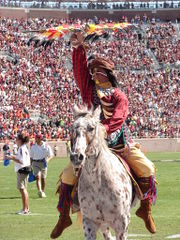
Appaloosas are used extensively for both Western and English riding. Western competitions include cutting, reining, roping and O-Mok-See sports such as barrel racing (known as the Camas Prairie Stump Race in Appaloosa-only competition) and pole bending (called the Nez Percé Stake Race at breed shows). English disciplines that they are used in include eventing, show jumping, and fox hunting. They are common in endurance riding competitions, as well as in casual trail riding. Appaloosas are also bred for racing, with an active breed racing association promoting the sport. They are generally used for middle-distance racing at distances between 350 yards and a half mile, and an Appaloosa holds the record for the 4.5 furlong distance, set in 1989.[58][59]
Appaloosas are often used in Western movies and television series as mounts for both cowboy and Native American characters. Examples included "Cojo Rojo" in the Marlon Brando film The Appaloosa[60] and "Zip Cochise" ridden by John Wayne in the 1966 film El Dorado.[61] An Appaloosa horse is part of the controversial mascot team for the Florida State Seminoles, Chief Osceola and Renegade, even though the Seminole people were not directly associated with Appaloosa horses.[62]
Other popular breeds with Appaloosa coloring and Appaloosa ancestry include the Pony of the Americas[63] and the Colorado Ranger.[64] Appaloosas are also crossbred with a number of gaited horse breeds in an attempt to create a leopard-spotted ambling horse. Because the ensuing offspring are not eligible for ApHC registration,[65] their owners are forming a number of new breed registries to promote gaited horses with spotted coats.[66]
Genetic and health issues
Blindness
Appaloosas have an eightfold greater risk of developing Equine Recurrent Uveitis (ERU) than all other breeds combined. Up to 25% of all horses with ERU may be Appaloosas. Uveitis in horses has many causes, including eye trauma, disease, and bacterial, parasitic and viral infections, but ERU is characterized by recurring episodes of uveitis, rather than a single incident. If not treated, ERU can lead to blindness, which occurs more often in Appaloosas than in other breeds.[67] Up to 80% of all uveitis cases are found in Appaloosas, with physical characteristics including light colored coat patterns, little pigment around the eyelids and sparse hair in the mane and tail denoting more at-risk individuals.[68] Researchers may have identified a gene region containing an allele that makes the breed more susceptible to the disease.[69]
Appaloosas that are homozygous for the leopard complex or "Lp gene" are also at risk for congenital stationary night blindness (CSNB). This form of night blindness has been linked with the leopard complex since the 1970s.[70] CSNB is a disorder that causes an affected animal to completely lack night vision, although day vision is normal. It is an inherited disorder, present from birth, and does not progress over time.[71] A 2008 study theorizes that both CSNB and leopard complex spotting patterns are linked to the gene TRPM1.[72]
Drug rules
In 2007, the ApHC implemented new drug rules which will allow Appaloosas to show with the drugs furosemide, known by the trade name of Lasix, and acetazolamide. Furosemide is used to prevent horses who bleed from the nose when subjected to strenuous work from having bleeding episodes when in competition, and is widely used in horse racing. Acetazolamide ("Acet") is used for treating horses with the genetic disease hyperkalemic periodic paralysis (HYPP), and prevents affected animals from having seizures.[Note 1] Acet is only allowed for horses that test positive for HYPP and have HYPP status noted on their registration papers.[73] The ApHC recommends that Appaloosas that trace to certain American Quarter Horse bloodlines be tested for HYPP, though testing is not mandatory,[74] and owners have the option to choose to place HYPP testing results on registration papers.[75]
Both drugs are controversial in part because they are considered drug maskers and as diuretics which can be used to make it difficult to detect the use of other drugs from the horse's system. For these and other reasons, this rule change has generated controversy.[76] On one side, it is argued that both the United States Equestrian Federation (USEF), which sponsors show competition for many different horse breeds,[77] and the International Federation for Equestrian Sports (FEI), which governs international and Olympic Equestrian, competition ban the use of furosemide.[78] On the other side of the controversy, several major stock horse registries that sanction their own shows, including the American Quarter Horse Association,[79][80] American Paint Horse Association,[81] and the Palomino Horse Breeders' of America,[82] allow acetazolamide and furosemide to be used with 24 hours of showing under certain circumstances.
See also
- Equine coat color genetics
- Equine coat color
Notes
- ↑ Acetazolamide is not to be confused with Acepromazine ("Ace"), a tranquilizer, which is illegal in all forms of competition.
Footnotes
- ↑ 1.0 1.1 1.2 1.3 1.4 1.5 1.6 The Appaloosa Museum. "History of the Appaloosa". The Appaloosa Museum. http://www.appaloosamuseum.org/cms/default.asp?contentID=521. Retrieved 2008-01-31.
- ↑ Crowell, Cavalcade, p. 298
- ↑ Peckinpah, Robert L. (January 1953). "Appaloosa Ancient History". Horse Lover's Magazine: 26–29.
- ↑ Richardson, The Appaloosa, pp. 12–16
- ↑ Bennett, Deb (March 1997). "Hot Spots". Equus 233: 57.
- ↑ 6.0 6.1 Crowell, Cavalcade, p. 299
- ↑ Richardson, The Appaloosa, pp. 17–18
- ↑ Bennett, Conquerors, p. 196
- ↑ Bennett, Conquerors, p. 207
- ↑ Bennett, Conquerors, p. 391
- ↑ 11.0 11.1 Spencer III, Dick (December 1958). "Appaloosas". Western Livestock Journal: 50, 53–55.
- ↑ 12.0 12.1 12.2 "Appaloosa History". Appaloosa Horse Club. http://www.appaloosa.com/association/history.htm. Retrieved 2008-01-31.
- ↑ 13.0 13.1 13.2 13.3 Moulton, The Lewis and Clark Journals, p. 333
- ↑ Bennett, Conquerors, p. 390
- ↑ Bennett, Conquerors, p. 390, 392
- ↑ Malone, et.al. Montana, p. 134
- ↑ 17.0 17.1 17.2 Malone, et.al. Montana, p. 135-136
- ↑ 18.0 18.1 Haines Appaloosa, pp. 92–95
- ↑ 19.0 19.1 Malone, et.al. Montana, p. 138
- ↑ Richardson, The Appaloosa, p. 23
- ↑ Richardson, The Appaloosa, p. 24
- ↑ Haines, Appaloosa, pp. 96–98
- ↑ 23.0 23.1 Crowell, Cavalcade, pp. 296–7
- ↑ Murphy, Michael (November 1995). "Nez Perce Launch Horse Breeding Program". Articles. Nez Perce Horse Registry. http://www.nezpercehorseregistry.com/11-96.html. Retrieved 2008-01-31.
- ↑ 25.0 25.1 25.2 "History of the ApHC". The Appaloosa Museum. http://www.appaloosamuseum.org/cms/default.asp?contentID=524. Retrieved 2008-01-31.
- ↑ 26.0 26.1 Haines, Appaloosa, p. 98
- ↑ "Appaloosa Museum". The Appaloosa Museum. http://www.appaloosamuseum.org. Retrieved 2008-01-31.
- ↑ Appaloosa Horse Club, Appaloosa Horse Club Stud Book, Vol. 1
- ↑ 29.0 29.1 Thorson, Juli S. (June 1997). "Claude Thompson: Appaloosa Forefather". Appaloosa Journal: 40–45.
- ↑ Appaloosa Horse Club, Appaloosa Horse Club Stud Book, Vol. 2&3
- ↑ "2009 Appaloosa Horse Club Handbook" (PDF). Appaloosa Horse Club. pp. Rule 204 A 1, 2, 3. http://www.appaloosa.com/pdfs/rulebook09.pdf. Retrieved 2009-10-24.
- ↑ Appaloosa Horse Club. "Appaloosa Horse Club Fact Sheet". Appaloosa Horse Club Website. Appaloosa Horse Club. http://www.appaloosa.com/popupwindows/factsheet.htm. Retrieved 2007-02-01.
- ↑ Sellnow, Les (September 1, 2008). "Overbreeding" (Registration required). The Horse. http://www.thehorse.com/ViewArticle.aspx?ID=12798. Retrieved 2009-10-24.
- ↑ Idaho Transportation Department. "Personalized Plates for Your Vehicle & Souvenir Sample Plates". Idaho Transportation Department. https://www.accessidaho.org/secure/itd/personalized/plates.html?ScriptForm.startstep=request&ScriptForm.startScriptForm.start.ScriptStepView.requestPLATE_TYPEvalue=11. Retrieved 2008-01-31.
- ↑ "Everything you need to know about the Appaloosa License Plate". Appaloosa Horse Club. http://www.appaloosa.com/popupwindows/licenseplate.htm. Retrieved 2008-01-31.
- ↑ 36.0 36.1 36.2 36.3 36.4 "2009 Appaloosa Horse Club Handbook" (PDF). Appaloosa Horse Club. http://www.appaloosa.com/pdfs/rulebook09.pdf. Retrieved 2009-10-24.
- ↑ "Appaloosa characteristics". Appaloosa Horse Club. http://www.appaloosa.com/registration/indentify.htm. Retrieved 2008-01-31.
- ↑ Richardson, The Appaloosa, pp. 27–28
- ↑ Harris, Horse Breeds of the West
- ↑ "Appaloosa Racing". Appaloosa Horse Club. http://www.appaloosa.com/race/racing.htm. Retrieved 2008-01-31.
- ↑ 41.0 41.1 41.2 "Guide to Identifying an Appaloosa". Appaloosa Horse Club. http://www.appaloosa.com/registration/indentify.htm. Retrieved 2008-01-31.
- ↑ "Appaloosa Horse". International Museum of the Horse – Horse Breeds of the World. Kentucky Horse Park. http://www.imh.org/breeds.php?pageid=8&breed=9&alpha=One. Retrieved 2008-01-31.
- ↑ 43.0 43.1 Terry, R. B.; Archer, S.; Brooks, S.; Bernoco, D.; Bailey, E. (2004). "Assignment of the appaloosa coat colour gene (LP) to equine chromosome 1". Animal Genetics 35 (2): 134–137. doi:10.1111/j.1365-2052.2004.01113.x. PMID 15025575. http://www.blackwell-synergy.com/doi/abs/10.1111/j.1365-2052.2004.01113.x?journalCode=age. Retrieved 2008-06-09.
- ↑ "Applications of Genome Study – Coat Color". Horse Genome Project. University of Kentucky. http://www.uky.edu/Ag/Horsemap/hgpcoatcolor.html. Retrieved 2008-07-03.
- ↑ "Introduction to Coat Color Genetics". Veterinary Genetics Laboratory, School of Veterinary Medicine. University of California-Davis. http://www.vgl.ucdavis.edu/services/coatcolor.php. Retrieved 2008-01-31.
- ↑ "What is the Appaloosa Project?". The Appaloosa Project. http://www.appaloosaproject.info/index.php?module=pagemaster&PAGE_user_op=view_page&PAGE_id=1&MMN_position=5:5. Retrieved 2009-10-25.
- ↑ "2009 Appaloosa Horse Club Handbook" (PDF). Appaloosa Horse Club. pp. Rule 205.C. http://www.appaloosa.com/pdfs/rulebook09.pdf. Retrieved 2009-10-24.
- ↑ "Appaloosa Horse Club: International Affiliates". Appaloosa Horse Club. 2008. http://www.appaloosa.com/clubs-affiliates/international/international.htm. Retrieved 2008-02-12.
- ↑ "Appaloosa Horse Club Sponsorship Levels" (pdf). Appaloosa Horse Club. http://www.appaloosa.com/pdfs/sponsorlevels.PDF. Retrieved 2008-02-12.
- ↑ "ApHC Membership". Appaloosa Horse Club. http://www.appaloosa.com/membership/membership.htm. Retrieved 2008-02-12.
- ↑ 51.0 51.1 "American Appaloosa Association". American Appaloosa Association. http://www.amappaloosa.com/mainpage.cfm. Retrieved 2008-01-31.
- ↑ "Performance Permit Program". Appaloosa Horse Club. http://www.appaloosa.com/registration/performance-permit.htm. Retrieved 2009-10-24.
- ↑ "The Appaloosa Project: Studies Currently Underway". The Appaloosa Project. http://www.appaloosaproject.com/index.php?module=pagemaster&PAGE_user_op=view_page&PAGE_id=1&MMN_position=5:5. Retrieved 2010-03-21.
- ↑ Holmes Spotted Pride p. 165
- ↑ "Famous horses". The Appaloosa Museum. 2007. http://www.appaloosamuseum.org/cms/famoushorses.asp. Retrieved 2008-12-31.
- ↑ Stanger, Fifty Years of Appaloosa History, p. 163
- ↑ "Tips for Registering Your Appaloosa". Appaloosa Horse Club. http://www.appaloosa.com/registration/tips-for-registration.htm. Retrieved 2008-01-31.
- ↑ Dutson, Storey's Illustrated Guide to 96 Horse Breeds of North America, pp. 74-78
- ↑ "How do people use Appaloosas?". The Appaloosa Museum. http://www.appaloosamuseum.org/cms/default.asp?contentID=528. Retrieved 2010-03-22.
- ↑ Wilson Animal Movies Guide p. 161
- ↑ Murphy, Caitriona. "Rid 'em like a real cowboy". Independent News & Media Plc. http://www.independent.ie/farming/news-features/ride-em-like-a-real-cowboy-1380570.html. Retrieved 2008-07-03.
- ↑ Powell, Robert Andrew (2005). "The debate over Indian mascots: does the NCAA's ban on Indian mascots and nicknames go too far, or not far enough? Fans—and tribes—are divided.". The New York Times Upfront. Scholastic, Inc. http://www.thefreelibrary.com/The+debate+over+Indian+mascots%3a+does+the+NCAA%27s+ban+on+Indian+mascots+...-a0139784006. Retrieved 2008-01-31.
- ↑ "A Brief History of the POA Breed and POAC". Pony of the Americas Club. http://www.poac.org/breed/history.htm. Retrieved 2008-02-01.
- ↑ "CRHA History". Colorado Ranger Horse Association. http://www.coloradoranger.com/History.html. Retrieved 2008-02-01.
- ↑ "2009 Official Handbook of the Appaloosa Horse Club" (PDF). Appaloosa Horse Club. pp. Rules 204, 205. http://www.appaloosa.com/pdfs/rulebook09.pdf. Retrieved 2009-10-24.
- ↑ "Breed Profiles". Gaited Horses. Fairwind WebPages. http://www.gaitedhorses.net/BreedProfile.shtml. Retrieved 2008-06-09.
- ↑ Sandmeyer, Lynne (July 28, 2008). "Equine Recurrent Uveitis (ERU)". The Appaloosa Project. http://www.appaloosaproject.info/index.php?module=pagemaster&PAGE_user_op=view_page&PAGE_id=40&MMN_position=68:68. Retrieved 2010-03-21.
- ↑ Loving, Nancy (April 19, 2008). "Uveitis: Medical and Surgical Treatment" (Registration required). The Horse. http://www.thehorse.com/ViewArticle.aspx?ID=11687. Retrieved 2010-03-21.
- ↑ "Abstracts: 36th Annual Meeting of the American College of Veterinary Ophthamologists, Nashville, TN, USA, October 12–15, 2005". Veterinary Ophthalmology 8 (6): 437–450. November 2005. doi:10.1111/j.1463-5224.2005.00442.x. http://www3.interscience.wiley.com/journal/118669468/abstract. "Based on these data, we conclude that a susceptibility allele for ERU in Appaloosas exists in the MHC region.".
- ↑ Witzel CA, Joyce JR, Smith EL. (1977). "Electroretinography of congenital night blindness in an Appaloosa filly". Journal of Equine Medicine and Surgery (1): 226–229.
- ↑ "Researchers Pinpoint Link Between Appaloosa Coloring and Night Blindness" (Registration required). The Horse. November 21, 2007. http://www.thehorse.com/ViewArticle.aspx?ID=10852. Retrieved 2009-02-07.
- ↑ Oke, Stacey, DVM, MSc (August 31, 2008). "Shedding Light on Night Blindness in Appaloosas" (Registration required). The Horse. http://www.thehorse.com/ViewArticle.aspx?ID=12595. Retrieved 2009-02-07.
- ↑ "2009 Appaloosa Horse Club Handbook" (PDF). Appaloosa Horse Club. 2008. p. Rule 40C, note. http://www.appaloosa.com/pdfs/rulebook09.pdf. Retrieved 2009-10-24.
- ↑ Nelson, Shonda (2008). "Hyperkalemic Periodic Paralysis (HYPP) Testing Procedures" (PDF). Appaloosa Horse Club. http://www.appaloosa.com/pdfs/HYPPTestingProcedures.pdf. Retrieved 2008-06-13.
- ↑ "HYPP Test Result Proecdures". Appaloosa Newsletter. Appaloosa Horse Club. December 2007. http://www.appaloosa.com/newsletter/2007/0712.htm. Retrieved 2008-06-13.
- ↑ "July 2007 Appaloosa Horse Club Board Motions" (PDF). Appaloosa Horse Club. http://www.appaloosa.com/pdfs/SummaryofMotions07_08_07.pdf. Retrieved 2008-01-31.
- ↑ "Drugs and Medication Guidelines" (PDF). United States Equestrian Federation. August 1, 2007. p. 1. http://www.usef.org/documents/competitions/2007/2007DrugsMedsGuidelines.pdf. Retrieved 2008-08-11. Note: Specifically lists Furosemide.
- ↑ "Equine Prohibited List" (PDF). Veterinary Regulations. Federation Equestre Internationale. 2009. p. 2. http://www.fei.org/Rules/Veterinary/Documents/Annex%20II%20-%20Equine%20Prohibited%20List.pdf. Retrieved 2009-10-24. Note: Bans use of diuretics generally with no exception for Furosemide.
- ↑ "AQHA Show Rules, Rule 441, Therapeutic Medication Addendum" (PDF). American Quarter Horse Association. http://www.aqha.com/association/registration/pdf/showrules_07.pdf. Retrieved 2008-01-31.
- ↑ American Quarter Horse Association. "Therapeutic Medication Fact Sheet" (PDF). AQHA Website. American Quarter Horse Association. http://www.aqha.com/showing/guidetoshowing/theraputicmed.html. Retrieved 2008-01-31.
- ↑ "APHA Rulebook". American Paint Horse Association. pp. 78–79, Rule CS-085. http://www.apha.com/forms/rulebooks.html. Retrieved 2008-01-31.
- ↑ "PHBA Rule Book" (PDF). Palomino Horse Breeders Association. pp. 77–78, Rule 2528A. http://www.palominohba.com/competitions/show_management/2008_2009_rule_book/. Retrieved 2009-10-24. The PHBA does not allow Lasix within 24 hours of show and only allows Acetazolamide for HYPP horses.
References
- Appaloosa Horse Club. Appaloosa Horse Club Stud Book Volume 1. Appaloosa Horse Club.
- Appaloosa Horse Club. Appaloosa Horse Club Stud Book Volume 2 & 3. Appaloosa Horse Club.
- Bennett, Deb (1998). Conquerors: The Roots of New World Horsemanship (First ed.). Amigo Publications. ISBN 0-9658533-0-6.
- Crowell, Pers (1951). Cavalcade of American Horses. New York: McGraw-Hill. OCLC 1428574.
- Haines, Francis (1963). Appaloosa: The Spotted Horse in Art and History. Austin, TX: University of Texas Press. ISBN 0912830212.
- Harris, Freddie S. (1973). Horse Breeds of the West. Cordovan Corp. OCLC 1583675.
- Holmes, Frank (2003). Spotted Pride. Loft Enterprises. ISBN 0971499829.
- Malone, Michael P., Richard B. Roeder and William L. Lang (1991). Montana: A History of Two Centuries. Seattle and London: University of Washington Press. ISBN 0295971290.
- Moulton, Gary E. (editor) (2003). The Lewis and Clark Journals. Lincoln and London: University of Nebraska Press. ISBN 0803280394.
- Richardson, Bill and Dona (1968). The Appaloosa. New York: A. S. Barnes. ISBN 0498067874.
- Stanger, Edith M. (1997). Fifty Years of Appaloosa History. Double Arrow Appaloosas. ISBN 0966116046.
- Dutson, Judith (2005). Storey's Illustrated Guide to 96 Horse Breeds of North America. Storey Publishing. ISBN 1580176127.
- Wilson, Staci Layne (2007). Animal Movies Guide. Running Free Press. ISBN 0967518539. http://books.google.com/?id=dGYzZLrBrS4C&pg=PA161&dq=animal+movies+guide+appaloosa.
External links
- Appaloosa Horse Club (USA)
- Appaloosa Museum
- American Appaloosa Association
- Appaloosa Horse Club of Canada
- Appaloosa Horse Club of Denmark
- Appaloosa Horse Club of Germany
- American Appaloosa Horse Club Holland
- Appaloosa Horse Association of New Zealand
- Appaloosa Horse Club of the United Kingdom
- Animal Planet Live Appaloosa Horse Cam
- Appaloosa Breeding in Argentina
|
||||||||||||||||||||||||||||
.jpg)